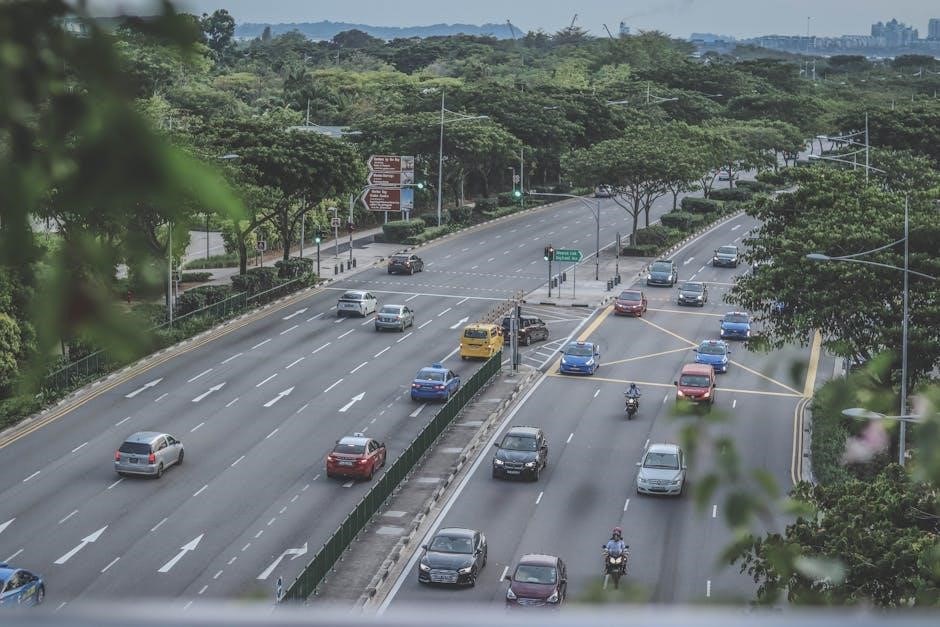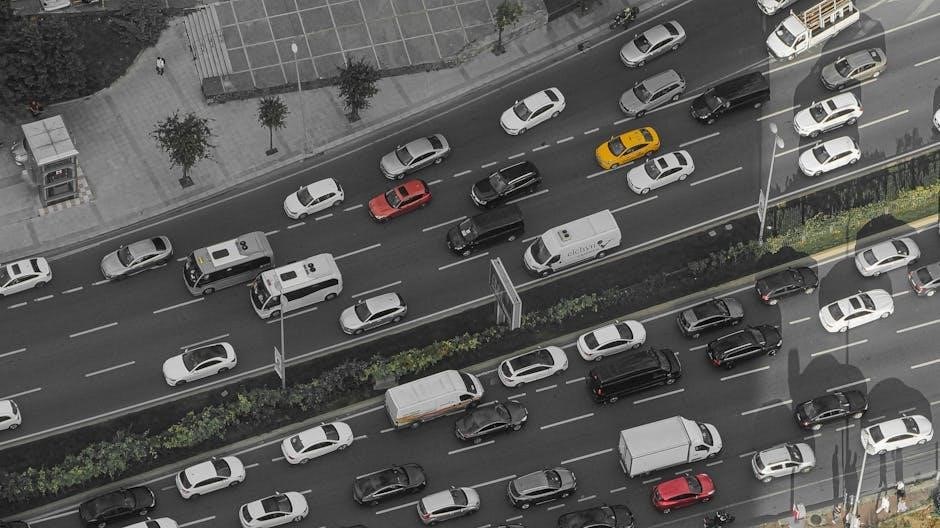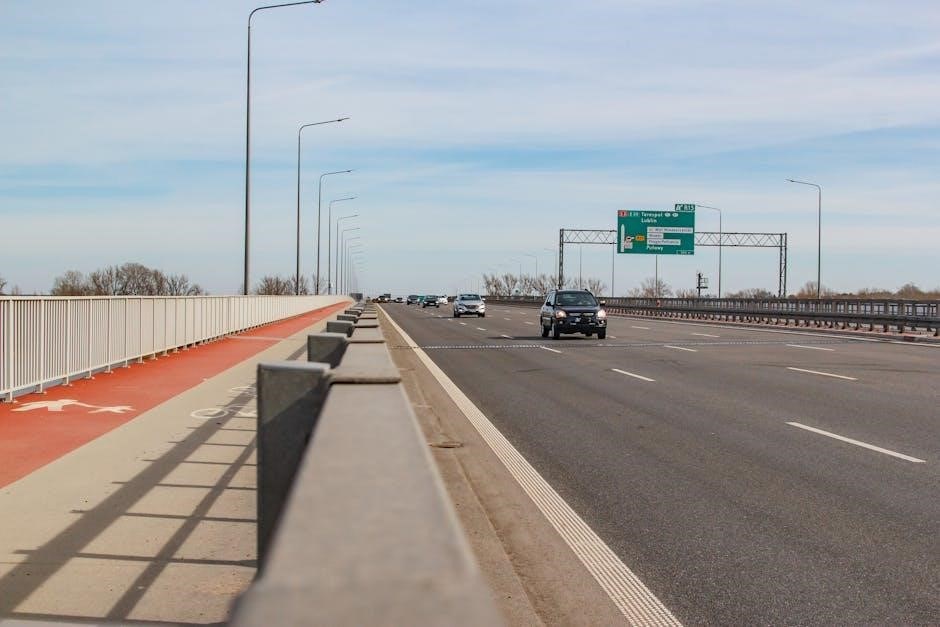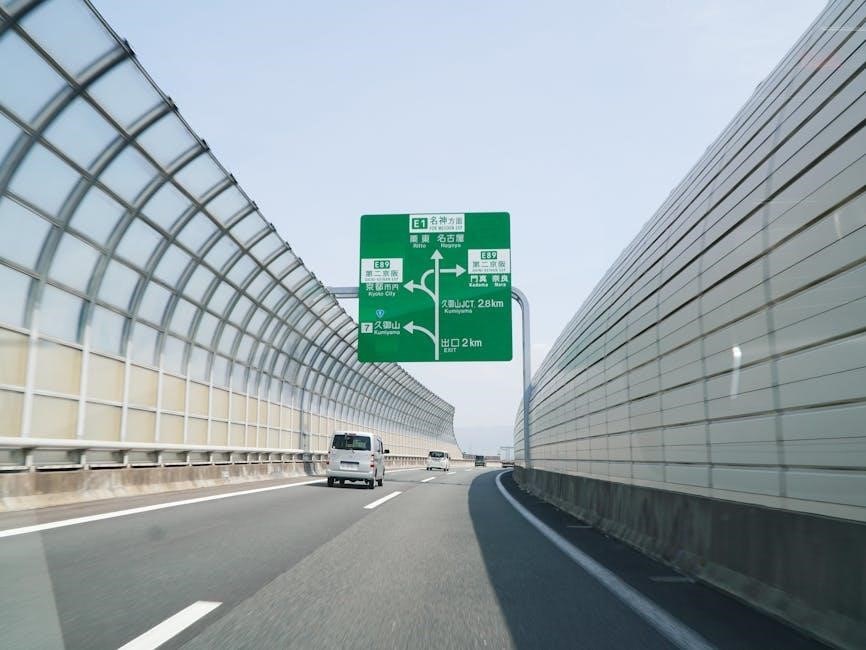
highway and expressway guide signs are
Highway and expressway guide signs are green with white letters, providing clear directions and distances to ensure safe and efficient navigation for drivers on high-speed roads.
1.1 Definition and Purpose
Highway and expressway guide signs are standardized visual aids designed to provide drivers with essential navigation information. These signs are typically green with white lettering, ensuring high visibility and readability. Their primary purpose is to guide motorists by indicating directions, distances, and locations of destinations, services, and points of interest. Guide signs are strategically placed to help drivers make informed decisions, reducing confusion and enhancing safety. They are particularly critical on high-speed roads, where split-second decisions are common; The design and content of these signs are governed by the Manual on Uniform Traffic Control Devices (MUTCD), ensuring consistency across jurisdictions. By offering clear and concise information, guide signs play a vital role in efficient traffic flow and driver convenience.
1.2 Importance of Guide Signs for Drivers
Guide signs are indispensable for ensuring safe and efficient travel on highways and expressways. They provide critical information about directions, distances, and destinations, helping drivers navigate with confidence. Clear and visible signage reduces confusion, especially on high-speed roads, where split-second decisions are necessary. By indicating upcoming exits, services, and points of interest, guide signs enable drivers to plan their routes effectively. This enhances traffic flow and minimizes the risk of accidents caused by sudden stops or last-minute lane changes. Additionally, guide signs contribute to driver convenience by directing motorists to rest areas, fuel stations, and emergency services, ensuring a safer and more comfortable journey. Their standardized design and placement are vital for maintaining order and safety on busy roadways.

Design and Standards for Guide Signs
Highway and expressway guide signs are green with white letters, adhering to MUTCD guidelines to ensure legibility and consistency, enhancing driver safety and navigation efficiency.
2.1 Color Scheme and Legibility
Highway and expressway guide signs are green with white letters, a standardized color scheme that enhances visibility and readability for drivers. The green background provides high contrast, making the white text stand out, especially at night or in low-light conditions. Legibility is further improved by the use of mixed-case lettering, where the first letter is uppercase and the rest are lowercase. This design choice reduces eye strain and ensures that drivers can quickly and accurately process the information. The color scheme and lettering style are governed by the MUTCD guidelines, ensuring consistency across all jurisdictions. These standards are critical for maintaining uniformity and maximizing the effectiveness of guide signs in high-speed environments. Proper visibility and readability are essential for driver safety and efficient navigation on highways and expressways.
2.2 Lettering Size and Case Requirements
Highway and expressway guide signs feature standardized lettering sizes to ensure optimal readability. Word messages on these signs must be in letters at least 200 mm (8 inches) high, with larger lettering used for major guide signs at interchanges and overhead signs. The use of mixed-case lettering, where the first letter is uppercase and the rest are lowercase, enhances readability and reduces eye strain for drivers. This design adheres to MUTCD guidelines, ensuring uniformity across jurisdictions. Proper lettering size and case are critical for quick comprehension, especially on high-speed roads where drivers have limited time to process information. These standards help maintain consistency and clarity, making guide signs effective navigational aids for motorists. The specifications are carefully designed to prioritize legibility and safety on highways and expressways.

2.3 Standardization Across Jurisdictions
Standardization of highway and expressway guide signs ensures uniformity in design and messaging across different regions and jurisdictions. The Manual on Uniform Traffic Control Devices (MUTCD) provides national guidelines, guaranteeing that signs are consistent in color, shape, and lettering. This consistency helps drivers easily understand guide signs, regardless of where they are traveling. Standardization also applies to the placement and sequencing of signs, ensuring drivers receive clear and timely information. By adhering to these standards, jurisdictions maintain safety and efficiency on high-speed roads. The use of identical designs and messaging across state and regional borders reduces confusion and enhances the overall effectiveness of guide signs in aiding navigation. This uniform approach is vital for maintaining clear communication with drivers on highways and expressways nationwide.
2.4 Compliance with MUTCD Guidelines
Compliance with the Manual on Uniform Traffic Control Devices (MUTCD) guidelines ensures that highway and expressway guide signs meet federal standards for design, placement, and messaging. The MUTCD mandates uniformity in sign designs, guaranteeing consistency across jurisdictions. This includes specifications for lettering size, color schemes, and the use of uppercase and lowercase letters. For example, guide signs must use green backgrounds with white letters, and letters must be at least 8 inches tall for visibility. The 11th Edition of the MUTCD introduced updated guidelines, including new sign designs and expanded requirements for digital signage. Compliance ensures that signs are easily recognizable and provide clear information, enhancing safety and efficiency for drivers on high-speed roads. Adherence to these guidelines is critical for maintaining uniformity and effectiveness nationwide.
Types of Guide Signs on Highways and Expressways
Guide signs include destination signs, distance signs, diagrammatic signs, and overhead signs, each providing specific information to help drivers navigate efficiently on highways and expressways.
3.1 Destination Guide Signs
Destination guide signs provide clear information about upcoming exits, road names, cities, and landmarks, helping drivers navigate effectively. These signs are typically green with white letters, ensuring high visibility. They often include exit numbers, distances, and directional arrows to guide motorists. The text is in mixed case for better readability, with initial uppercase letters for place names. These signs are essential for decision-making, especially on high-speed roads, and are placed at strategic locations to allow ample time for drivers to react. They comply with MUTCD guidelines, ensuring uniformity and consistency across jurisdictions. Destination signs are crucial for safe and efficient travel, reducing confusion and enhancing overall driving experience.
3.2 Distance Guide Signs
Distance guide signs provide motorists with essential information about the remaining miles to upcoming exits, cities, or points of interest. These signs are typically green with white letters, ensuring high visibility. They list destinations in a clear format, often alongside corresponding distances, to help drivers plan their journey. Larger signs are used at major interchanges to enhance readability. The text on these signs follows MUTCD guidelines, with mixed-case lettering for better legibility. Distance guide signs are critical for helping drivers make informed decisions about when to exit or adjust their route. They are particularly important on high-speed roads, where advance notice is necessary for safe maneuvering. These signs complement destination guide signs, offering a comprehensive navigation aid for motorists. By providing accurate distance information, they reduce driver confusion and enhance travel efficiency. Distance guide signs are a vital component of the highway signage system, ensuring drivers can navigate confidently and efficiently. They are consistently designed and placed to meet driver needs, adhering to standardized guidelines for clarity and effectiveness. This consistency helps drivers trust and rely on the information provided, making their journeys safer and less stressful. The use of uniform colors and formats across jurisdictions further enhances their effectiveness, as drivers can easily recognize and understand the signs regardless of location. Overall, distance guide signs play a key role in supporting safe and efficient travel on highways and expressways. By offering clear and timely information, they help drivers stay informed and in control throughout their journey. This supports the overall goal of guide signs, which is to provide accurate and helpful information to motorists. Distance guide signs are an essential tool for navigating modern roadways, and their design reflects a deep understanding of driver needs and behaviors. They are a cornerstone of effective traffic management and driver assistance, ensuring that motorists can reach their destinations safely and efficiently. The importance of these signs cannot be overstated, as they directly impact the safety and convenience of travel on high-speed roads. By providing critical distance information, they empower drivers to make better decisions and reduce the likelihood of accidents caused by last-minute maneuvers. The continued refinement of distance guide signs, based on driver feedback and technological advancements, will further enhance their effectiveness in supporting safe and efficient travel. As road networks evolve, the role of distance guide signs will remain central to ensuring that drivers have the information they need to navigate confidently. Their enduring importance underscores the value of well-designed signage in modern transportation systems. By prioritizing clarity, consistency, and driver-centric design, distance guide signs set a high standard for roadway communication. Their impact on driver behavior and safety is significant, making them a fundamental element of highway infrastructure. The integration of distance guide signs into larger navigation systems, such as GPS and digital maps, further amplifies their utility, creating a seamless and supportive driving environment. Through their thoughtful design and strategic placement, distance guide signs continue to be an indispensable resource for motorists, helping to make travel safer, more efficient, and less stressful. They exemplify the principles of effective communication in transportation, demonstrating how well-designed signage can positively influence driver behavior and overall traffic flow. The ongoing development of these signs will remain crucial as transportation needs and technologies continue to evolve. By staying aligned with driver needs and advances in signage technology, distance guide signs will maintain their critical role in supporting safe and efficient travel for years to come. Their legacy as a cornerstone of highway safety and navigation ensures that they will remain a vital component of road infrastructure, continually adapting to serve the needs of motorists. The enduring value of distance guide signs is a testament to the importance of clear and effective communication in transportation systems. They serve as a prime example of how well-designed signage can make a meaningful difference in driver safety and satisfaction. By providing accurate and timely information, distance guide signs empower drivers to navigate complex road networks with confidence and ease. Their role in reducing driver stress and enhancing travel efficiency cannot be overstated, making them an essential element of modern transportation infrastructure. The continued refinement and evolution of distance guide signs will ensure that they remain a trusted and reliable resource for motorists, supporting safe and efficient travel for generations to come.
3.4 Diagrammatic and Overhead Signs
Diagrammatic and overhead signs provide visual representations of complex intersections or exits, helping drivers navigate high-speed roads. These signs often include maps or schematics showing the layout of interchanges, allowing motorists to anticipate lane changes or exits. Overhead signs are large, mounted above the roadway, and feature bold text and arrows for clear guidance. They are particularly useful in high-traffic areas where drivers need quick, easy-to-understand information. Diagrammatic signs use symbols and graphics to convey directions, making them especially helpful for drivers unfamiliar with the area. Both types of signs are designed for maximum visibility and are often illuminated for nighttime readability. They are critical for reducing confusion and ensuring smooth traffic flow at busy interchanges. These signs are standardized to ensure consistency across jurisdictions, adhering to MUTCD guidelines for design and placement. By combining visual and textual information, diagrammatic and overhead signs enhance driver comprehension and safety on highways and expressways. Their strategic placement and clear design make them indispensable for navigating complex roadways effectively. These signs are regularly updated to reflect changes in road layouts and traffic patterns, ensuring they remain relevant and effective. Their role in modern transportation infrastructure is vital, as they help drivers make informed decisions quickly and confidently; The integration of diagrammatic and overhead signs into the broader guide sign system underscores their importance in maintaining efficient and safe traffic flow. They exemplify how signage can adapt to the needs of drivers, providing intuitive guidance even in the most challenging environments. By leveraging both visual and textual elements, these signs set a high standard for clear and effective communication on the road. Their continued evolution will ensure they remain a cornerstone of highway signage systems, supporting safe and efficient travel for years to come. The combination of diagrams and overhead messaging creates a powerful tool for driver navigation, demonstrating the importance of innovative signage in modern transportation. These signs are a testament to the ongoing effort to improve road safety and driver experience through well-designed guidance systems. They play a pivotal role in reducing accidents caused by confusion or last-minute decisions, ensuring that drivers can navigate complex intersections with confidence. The use of diagrammatic and overhead signs reflects a deep understanding of driver behavior and the need for clear, intuitive guidance on high-speed roads. By addressing the challenges of modern driving, these signs contribute significantly to the overall safety and efficiency of transportation networks. Their impact is evident in the reduced congestion and improved flow at busy interchanges, where clear guidance is essential. As transportation systems continue to evolve, the role of diagrammatic and overhead signs will remain crucial, adapting to new technologies and driver needs while maintaining their core purpose of providing clear and effective navigation assistance. These signs are a prime example of how thoughtful design and strategic placement can enhance the driving experience, making them an indispensable part of highway infrastructure. Their ability to convey complex information in a simple and intuitive manner ensures they will remain a vital component of guide sign systems for the foreseeable future. By prioritizing clarity and driver-centric design, diagrammatic and overhead signs set a high standard for roadway communication, supporting safer and more efficient travel for all motorists.

Placement and Visibility of Guide Signs

Guide signs are strategically placed in advance of exits and interchanges, mounted overhead on high-speed roads, and designed to be large and visible, ensuring clarity for drivers.
4.1 Advance Signs for Exits and Interchanges
Advance guide signs are placed before exits and interchanges to inform drivers of upcoming exits, distances, and directions. These signs are crucial for safe navigation on high-speed roads, allowing drivers ample time to prepare for lane changes or exits. They typically include directional arrows, exit numbers, and distances to ensure clarity. The placement follows MUTCD guidelines, ensuring consistency and visibility. Larger signs with bold lettering are used for major interchanges, while smaller signs are reserved for less complex exits. The color scheme, usually green with white letters, enhances readability, especially at night or in low-light conditions. This systematic approach helps reduce driver confusion and promotes smooth traffic flow.
4.2 Overhead Signage for High-Speed Roads
Overhead guide signs are prominently placed above high-speed roads to provide clear directional information to drivers. Their large size and elevated position ensure visibility from a distance, even at high speeds. These signs typically feature bold lettering and arrows to indicate lanes for specific destinations, helping drivers make timely decisions. The color scheme, often green with white letters, enhances readability under various lighting conditions. Overhead signage is especially critical at complex interchanges, where multiple routes converge, reducing confusion and promoting smooth traffic flow. Their strategic placement and standardized design align with MUTCD guidelines, ensuring consistency and safety for motorists navigating busy highways and expressways.
4.3 Placement at Interchanges and Merges
Guide signs at interchanges and merges are strategically positioned to provide clear directions, ensuring safe navigation through complex areas. Overhead and ground-mounted signs are used, with larger lettering for enhanced visibility. Advance signs are placed well before decision points, allowing drivers ample time to react. Arrows and diagrams often accompany text to simplify route choices. The placement adheres to MUTCD guidelines, prioritizing consistency and driver safety. These signs are critical in high-traffic zones, minimizing confusion and reducing the risk of accidents. Their design ensures readability even at high speeds, making them indispensable for efficient traffic flow at interchanges and merges.

Information Provided by Guide Signs
Guide signs provide directions, distances, exits, rest areas, and points of interest, ensuring drivers stay informed and navigate efficiently on highways and expressways.
5.1 Upcoming Exits and Interchanges
Guide signs for upcoming exits and interchanges are essential for navigation, providing drivers with advance notice of exits, distances, and directions to destinations. These signs are typically green with white letters, ensuring high visibility. They often include exit numbers, road names, and arrows to indicate directions, helping drivers prepare for lane changes. Larger lettering and clear graphics are used for major interchanges to enhance readability at high speeds. Advance signs are placed at strategic intervals, giving drivers sufficient time to react. Compliance with MUTCD guidelines ensures consistency across jurisdictions, making it easier for drivers to understand and follow the information provided. These signs are critical for maintaining traffic flow and reducing congestion at interchanges.
5.2 Directions to Rest Areas and Services
Guide signs directing drivers to rest areas and services are crucial for traveler convenience and safety. These signs provide information about the location of rest stops, food establishments, lodging, and fuel stations. They are designed to be easily readable, with green backgrounds and white text, ensuring visibility even at high speeds. Arrows and distances are often included to guide drivers to these facilities. Such signs help prevent driver fatigue by allowing motorists to plan breaks in advance. Additionally, they promote local businesses and amenities, enhancing the travel experience. Compliance with MUTCD guidelines ensures consistency in the design and placement of these signs, making them reliable for drivers across different regions. This feature is particularly beneficial for long-distance travelers needing regular breaks.
5.3 Points of Interest and Landmarks
Guide signs highlighting points of interest and landmarks provide travelers with valuable information about cultural, historical, or natural attractions along their route. These signs are designed to inform drivers about notable locations, encouraging exploration and tourism. They often feature symbols or names of significant sites, such as national parks, monuments, or historic buildings. By indicating distances and directions to these attractions, the signs help travelers plan their journeys and discover new destinations. The inclusion of such information enhances the driving experience, making trips more enjoyable and informative. These signs are strategically placed to ensure visibility while maintaining traffic flow, adhering to MUTCD standards for clarity and consistency. They serve as a vital resource for travelers seeking to explore local treasures.
Regulatory Compliance and Updates
Highway and expressway guide signs must comply with MUTCD and SHS standards, ensuring uniformity and safety. Updates in the 11th Edition of MUTCD introduce new design guidelines and obsolete outdated signs.
6.1 Updates in the 11th Edition of MUTCD
The 11th Edition of the MUTCD introduces updated design guidelines for highway and expressway guide signs, enhancing safety and clarity. It includes expanded details for sign designs, pavement markings, and symbolic traffic signals. New sign layouts and revised standards aim to improve driver comprehension. The updated edition also addresses the obsolescence of certain older signs, ensuring consistency across jurisdictions. Additionally, the Standard Highway Signs (SHS) publication will be revised to reflect these changes, providing a comprehensive resource for designers. These updates align with modern traffic needs, emphasizing uniformity and innovation in guide signage to support efficient and safe navigation on high-speed roads.
6.2 Obsolete Signs and Discontinued Designs
The 11th Edition of the MUTCD has led to the discontinuation of certain outdated guide sign designs, ensuring improved uniformity and safety. Older sign designs that no longer meet current standards are being phased out and replaced with updated versions; This includes signs whose formats or lettering styles do not align with modern legibility requirements. The Federal Highway Administration emphasizes that non-compliant signs must be updated during routine maintenance or replacements. Additionally, the 2004 Edition of the Standard Highway Signs (SHS) and its 2012 Supplement will become obsolete once the 2024 SHS is fully published. This transition ensures consistency and clarity, avoiding confusion for drivers caused by outdated signage.
Future Trends in Guide Signage
Future trends include integrating digital and smart signage for real-time updates, enhancing visibility with improved reflectivity, and adopting standardized designs for better driver comprehension and safety.
7.1 Integration of Digital and Smart Signage

The integration of digital and smart signage is revolutionizing highway and expressway guide signs by enabling real-time updates and dynamic messaging. These advanced systems use electronic displays to provide current information about traffic conditions, weather alerts, and route changes. Digital signs are more versatile than traditional static signs, allowing authorities to adapt messaging quickly in response to emergencies or construction. Additionally, smart signage can integrate with vehicle-to-infrastructure technologies, offering personalized directions and enhancing safety. The Federal Highway Administration is actively promoting these innovations through updated design guidelines in the Standard Highway Signs publication. As technology advances, digital and smart signage will become a standard feature on modern highways, improving driver experience and reducing congestion. This shift ensures guide signs remain effective in an increasingly connected and dynamic transportation environment.
7.2 Enhanced Visibility and Reflectivity Standards
Enhanced visibility and reflectivity standards are critical for ensuring highway and expressway guide signs are easily readable, especially at night or in low-light conditions. Modern materials and technologies, such as microprismatic reflective sheeting, are being widely adopted to improve sign visibility. These advancements increase the durability and effectiveness of signs, reducing maintenance costs over time. The Federal Highway Administration has updated guidelines in the MUTCD to emphasize higher reflectivity levels, ensuring consistency across jurisdictions. Additionally, improved lighting designs for overhead signs are being implemented to enhance visibility without causing glare. These standards aim to reduce driver confusion and accidents, fostering safer and more efficient travel on high-speed roads. Ongoing research continues to refine these technologies, ensuring guide signs remain highly visible and effective for years to come.